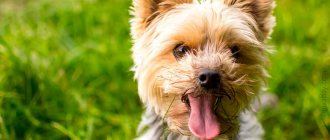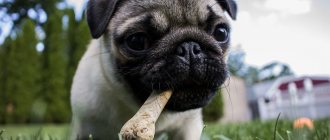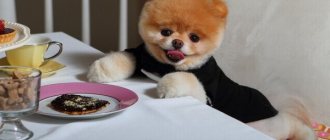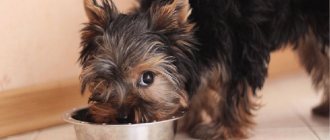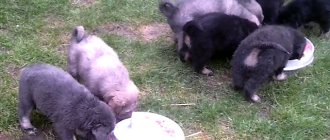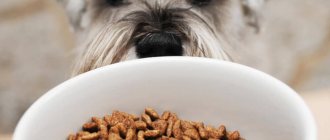Toy terriers are small dogs, so their nutrition at any age must be approached with caution. Well, the question of the puppy’s nutrition is completely relevant.
Moreover, you need to write out the menu for a small pet literally by month. That's what we'll do now. And let’s make a reservation right away: we won’t talk about dry food; there are recommendations for each age on the packaging.
Breed Features
Toy Terriers are small but very energetic. A small portion of food should provide your pet with:
- proteins (proteins);
- fats;
- carbohydrates;
- vitamins;
- minerals.
When composing a diet, it should be taken into account that the stomach of an adult dog can optimally accommodate the volume of one tablespoon. A puppy's is much smaller. Of course, the stomach is a muscular organ that can stretch and increase several times, but is this good?
Important! When feeding a puppy, overeating should not be allowed. A low content of energy substances per serving will be accompanied by a constant search for food and an increase in the volume of food eaten. Excessively high-calorie feeding is also unacceptable.
The most energy-rich fats and carbohydrates, especially fast ones (sugars). For a carnivore, especially small breed dogs, there is no need for large quantities of such components.
Useful video
Here you can find out a lot of interesting information about the Russian Toy Terrier. The video provides advice regarding small pets.
Choosing a place to eat and dishes
Each owner solves this issue in his own way. When organizing a “dining room”, you need to consider several points.
The feeding area should be:
- light;
- secluded (a dog having lunch should not disturb the household and they should not disturb it);
- easily accessible for both the animal and the owner;
- equipped with a easily washable surface;
In small apartments, the puppy’s feeding place is determined in the kitchen. In this case, the doors are left constantly open, this will provide free access to a bowl of food and water. If the area allows and the dog has its own “room”, then the feeding place will be equipped in it. The distance from the resting place to the bowl should be significant.
When choosing dishes, you should take into account that the full amount of food should occupy only half the volume of the bowl. The dishes should not be allowed to:
- moved;
- capsized;
- jumped up while eating food.
The material from which the bowl is made must be food-grade, high-quality, and durable. Bowls for water and food should be nearby, but not interfere with each other. For this breed there is no need to set up a feeding area at higher elevations. If the owner intends to feed the puppy “from the table,” there should still be room for a bowl. Initially, it is necessary to accustom the dog to it. In the future, this will make it possible to understand that the dog is hungry (when approaching the bowl and sniffing).
Correct “dog” diet, portions and proportions
The pet's menu should consist of food that its distant relatives eat. This includes not giving your dog cucumbers, even if “he loves them so much and asks for them all the time.”
Take the Attention Test! Find 10 differences! (click right here!)
Find the answer Are you bothered by some problem or question? Enter “Breed” or “Name of the problem” into the form, press Enter and you will find out everything about the issue that interests you.
Ingredients and proportions. Normal food for any dog is meat and porridge, which should form the “main course”. The approximate ratio is 1:2, respectively: for one part of porridge meat - 2 parts. You can diversify your pet's diet with low-fat cottage cheese and low-fat kefir. The emphasis should be on “lean”, this applies to meat, fatty foods are completely contraindicated for them - they cause problems with the pancreas. For these reasons, it is not advisable to choose pork as a meat ingredient in feeding.
The dog is a carnivore and has a correspondingly short intestine compared to omnivores (like us) and herbivores. Many foods rich in fiber simply pass through their digestive tract without bringing any benefit, or even harm. This doesn't mean they don't need fiber. The main cereals to use in your pet's diet are rice, buckwheat or oatmeal. You can choose the porridge that he will eat with great pleasure.
The diet of any dog must be strict. An adult (although it always looks like a baby) can eat twice a day - in the morning and in the evening. You can break feeding into more portions, but the weight of the total amount of these portions should be unshakable. If he follows you around all day with a pleading look, the portion should not exceed the daily requirement. Overfeeding can cause serious health problems, such as obesity, which will lead to other pathologies.
Since this is the smallest breed, it is advisable to give food in portions throughout the day, at least three times a day. The smaller the animal, the faster their metabolism, they are more often active and emotional animals.
The dog needs to be fed after the owner, although this is more a matter of education. But being well-mannered is often even good for your health. In case of health problems, it will be more realistic to provide help quickly to a well-mannered dog than to an aggressive, spoiled, disobedient one. You cannot give in to pity and treat her from the table. Love lies in care, and care should be aimed at the health of the pet. Teach her respect, patience, and you will be able to dine without the constant supervision of pleading eyes.
Feeding from the table. It is strictly forbidden to feed the animal food “from the table”, soups that are cooked for the family and other dishes; we prefer to eat salty food, which is unacceptable for dogs. There should be no spices, no salt. What is not good for a person is not good for a dog. Avoid eating chocolate! No matter what eyes she makes, chocolate is prohibited, because it is dangerous to their health.
If your dog has eaten something and there is something alarming about its condition, you should contact a veterinary clinic.
Food allergies. This is a common problem among dogs. The cause is not always genetically determined. If an animal has an allergy, it means that most likely it ate something that it did not need. Owners who dote on their pets often go overboard in terms of treats and indulgence for their kids. Food allergies are the most “harmless” consequence of such feeding disorders.
The allergen is protein. Therefore, in the process of fighting allergies, you need to pay attention to this, remove all meat from the diet, and instead introduce meat from an animal that is not yet “familiar” to the dog’s body. The process of getting rid of allergies is long, and it is not possible to expect results too soon.
Different types of meat can give a cross-reaction; do not blame the doctor if you cannot get rid of the allergy as quickly as you would like. You shouldn't be surprised if your dog has been living on his diet for a long time and the vet is ranting about food allergies. Allergies in dogs are a cumulative and long process, and the doctor knows about it. Trust him, and your pet will be able to get rid of allergies and choose the right diet for it. Sometimes it will be more rational to switch the animal to industrial hypoallergenic food (we’ll talk about the benefits of dry food a little further); if there is a positive reaction to such a change in diet, the diagnosis of food allergy will be confirmed.
What to feed a toy terrier puppy
When choosing one or another feeding diet, for this dog the issue of savings and pricing policy will not arise, since she does not eat much. This makes some things easier.
When choosing a feeding method, you need to consider the following aspects:
- usefulness for the animal;
- practicality;
- convenience.
After weighing everything, you can give preference to any particular type, or combine feeding.
Natural diet
A dog is a predator, a carnivore. Her body needs food of animal origin:
- milk and dairy products;
- meat, bones and offal;
- eggs;
- fish.
Consequences of improper feeding of a puppy
Many factors influence a puppy's health. Overeating or feeling hungry, or not eating according to the schedule. Food taken at the same time is necessary, since gastric juices and enzymes are constantly produced, only at the appointed time. Food that is not taken according to the schedule is not digested by gastric juice, which can result in indigestion of the entire stomach. Since vitamins do not enter the body with unbalanced food, useful substances are not produced, there is the possibility of hypotavitaminosis, vomiting, diarrhea, metabolic disorders, and constipation. If you leave the puppy alone at home, he will squeak and call you, thereby losing his voice and making it hoarse, and he may overexert himself and earn a hernia.
After you have not fed your pet for a long time, you will try to give him more food, he will eat everything with pleasure. The belly will be full and heavy, but since puppies have a lot of energy, he will not sit still, he will start playing, running, jumping. This can cause the spine to sag under the weight of the stomach. Monitor your pet's health. FOR proper and regular nutrition.
Feeding puppies - methods
Artificial feeding of puppies, replacement of bitch milk and first food
Source
Ready-made feed
Those specialists who have dealt with laboratory tests of feed can authoritatively state that the content of substances in feed does not correspond to what is written on the label. Unfortunately, manufacturers are well aware of how dry food testing works. Since it is not always possible to measure the quantitative composition of the substances stated in the recipe.
Both “simple” manufacturers and well-promoted product brands are guilty of inconsistency in composition. Very often, feed does not contain the required amount of vitamins and microelements, and expensive natural proteins are replaced with artificial amino acids.
High temperatures during production “kill” even heat-stable vitamins. Consequently, such food cannot fully provide the body with everything it needs.
When choosing food, you cannot rely on someone else’s opinion and experience. The food may be suitable for one dog, but cause pathology for another.
In any case, when deciding to feed dry food, you should give preference to:
- professional;
- designed for small breeds;
- labeled (indicating the composition, standard, date of production, address of the manufacturer).
Advantages
Without a doubt, feeding ready-made food is easy. If decent food is found and the puppy is cheerful, energetic, has good growth, and has no problems with the skin and mucous membranes, then it can be used.
Disadvantages of ready-made feeds
The disadvantages can be listed as follows:
- uncertainty of composition;
- imbalance of components;
- even expensive food contains preservatives and emulsifiers, which can cause pathology in the body;
- frequent replacement of natural ingredients with artificial additives.
Rating of the best dry food
When the owner does not have time to stand at the stove preparing food for the pet, they switch to dry food. Manufacturers offer industrially produced balanced nutrition. It will replenish missing vitamins and minerals and energize your pet.
- Acana – contains lamb meat, which does not cause allergies in toy terriers. Food is given to toy terrier puppies after the withdrawal of mother's milk.
- Orijen – contains no more than 15% carbohydrates. The composition contains a large percentage of meat and offal.
- Eukanuba Puppy & Junior All Breeds - suitable for many breeds, but some options are designed for Toy Terriers.
- Belgian food Grandorf - contains meat products and cereals. It contains chondroitin, which has a beneficial effect on the cartilage and ligaments of fragile dogs.
- Pedigree economy class food is affordable for every dog owner.
When choosing what to pamper your pet with - natural food or dry food, it is important to understand the complexity of daily preparation of healthy food. If it is not possible to stick to the correct menu, it is better to choose high-quality commercially produced food.
Mixed feeding
Experienced dog breeders increasingly prefer a mixed type of feeding. If you take a natural diet as a basis, and sometimes “pamper” your dog with dry food, you can better balance the diet.
When offering dry food to your puppy, monitor his reaction. If eaten willingly, they can be included in the diet, but should not be abused.
Dry food can be temporarily introduced into the diet if the dog is traveling. In this case, you need to “check” them in advance for palatability and non-allergenicity.
Veterinarian advice
Everyone has a fear of giving their pet a product of inferior quality. In order not to harm the toy terrier, it is advisable to choose food from a trusted manufacturer with a high content of animal proteins. Well-known brands, especially the premium segment, do not use meat waste - horns, skins, hooves.
Whatever the type of food for a toy terrier, you should not limit its drinking. Water should always be available to your pet. This is especially important when eating dry food. It is better to choose Holistic type food; they contain a sufficient amount of meat products, cereals, and vitamin and mineral supplements.
Dogs are prohibited from giving watermelon, grapes, and pasta.
To see the joyful eyes of a dog every day, it is enough to adhere to the basic rules in organizing his life.
A Toy Terrier should always have:
- in a bowl there is clean water, fresh food;
- The diet includes vitamin and mineral complexes.
When choosing between dry food and preparing food at home, in natural conditions, it is better to rely on your own strengths, because the pet’s development will depend only on the owner.
A dog always brings pleasant emotions to its owner. By following the tips for organizing proper nutrition, you can raise a healthy toy terrier without problems with the gastrointestinal tract.
Sample menu by age
Initially, the puppy suckles from its mother up to 12 times a day. Further, the multiplicity gradually decreases. When artificial feeding, the regimen should also be followed depending on age.
Feeding up to a month
If there are not many puppies in the litter, and the female feels well, then the milk will last up to 3-4 weeks. If maternal feeding is not enough, then this will be visible in the puppies. The cubs will be in constant search, and the bitch will constantly run away. This signal should be perceived as the beginning of feeding.
Puppies are offered warm, slightly sweetened milk with the addition of chicken egg yolk. You can start with 10-20 ml 4-5 times a day. Careful observation of behavior, growth and development will tell you the frequency and quantity.
When offering fresh cottage cheese and minced boiled meat, you should start with 5-6 g. No more than one product is introduced into the diet daily.
Attention! Puppies should not go hungry.
Age group 1 – 2 months
From this age, boiled fish, coarsely ground meat and boiled bone can be introduced into the diet.
The puppy gradually independently determines its taste preferences. However, this does not mean feeding just one favorite product. The more varied the menu, the more balanced the feeding.
The norm is 1-2 tablespoons with a frequency of 5-6 times a day.
Age group 2 – 4 months
From this age, we reduce the frequency of feeding to 4 times a day. The ration content remains at the same level. Raw cow's milk can be gradually removed. Yogurt should take its place.
4 – 6 months
The frequency is gradually increased to 3 times a day. The amount of food in the plate increases depending on the appetite and state of the animal’s body.
From 6 months to 1 year
At this age, the toy terrier can already be fed 2 times a day. The total amount is 1-2 tablespoons per feeding. This amount must include at least 3 components (for example: cottage cheese, meat, fish).
Tastes and preferences are already fully formed. The puppy is accustomed to the bowl. If he is energetic enough and constantly in search of food, increase the calorie content slightly by adding meat, sour cream and fatty fish.
Natural food or artificial food?
Toy Terriers are miniature dogs that require little food. At the same time, small portions should contain everything necessary for the healthy growth and development of the puppy.
It is important to maintain a balance of proteins, fats, vitamins, carbohydrates, fiber, fatty acids and minerals.
At home, representatives of this breed can be fed with both natural products and industrial feeds, the main thing is to avoid mixing both types of food.
The advantage of natural feeding is its diversity, the absence of flavors, dyes and other chemical additives.
Ready-made food, in turn, is popular due to its ease of use and balanced composition, containing everything necessary for the harmonious development of a dog..
Expert opinion
Kozhevin Semyon Kirillovich
Expert dog handler.
Most professional breeders opt for ready-made food, since this type of feeding is as simple as possible and does not have a negative effect on the dog’s body. After purchasing a puppy, the new owner can switch it to natural food. At the same time, it is necessary to understand that feeding natural products does not mean that the pet can eat food from the common table - for the dog you will need to cook separately and every day. If you don’t have confidence in your own abilities regarding daily cooking and creating a balanced menu, it is better to opt for high-quality food, since experiments with nutrition will have a negative impact on your pet’s health.
Vitamins and supplements
The condition of the skin, fur, mucous membranes and teeth is an indicator of the dog’s health. If the puppy is playful, energetic, and has constantly formed fecal masses, then there is no need for vitamins and supplements.
If the slightest pathology is detected, you should consult a veterinarian. A vitamin preparation is a medicine and should be prescribed by a specialist based on the results of the examination and tests performed.
Why bones should be thrown in the trash
Contrary to popular belief and dogs' passion for bones, they should not be given to pets. Dogs are animals that eat food hastily, in large chunks, without chewing it thoroughly.
A dog can accidentally swallow a large bone, which can cause a variety of problems:
- The dog may choke - if first aid is not provided in time, it can be lost; the owner does not always manage to get to the place where the bone is stuck;
- Smaller pieces of bones that successfully reach the intestines can stop there, causing a blockage that may not be immediately recognizable, but signs will be abdominal pain, lack of stool, vomiting (due to peristalsis disorders);
- The sharp ends of the bones can damage the wall of the esophagus, stomach, intestines, and even provoke perforation of the wall, and this condition is dangerous for the animal, leading to peritonitis - inflammation in the abdominal cavity, which is a serious condition. Often such animals cannot be saved.
Bones should be thrown in the trash and care should be taken that the dog cannot get to them.
Water
There should be a bowl of water next to the food bowl. Even if there is no food, water should always be in the bowl.
Water for a dog should be:
- fresh (change 2 times a day);
- clean;
- drinking.
There is no need to boil water.
You need to monitor your puppy's drinking habits. Low water consumption, as well as increased thirst, may indicate pathology.
Important! At the slightest deviation in one direction or another, you should seek advice from a specialist.
General recommendations for healthy eating
The quality of feeding of a toy terrier determines its development, health and coat.
In addition to the fact that nutrition should be complete and balanced, you should adhere to the following rules:
- feeding should take place at the same time every day;
- Clean drinking water should always be freely available;
- food should be at room temperature or slightly warmer;
- treats and treats should only be given during main meals;
- It is forbidden to feed the dog from the common table;
- food should be prepared from fresh, high-quality products without adding spices or salt;
- If there is food left in the bowl after a meal, the portion should be reduced; if there is not enough food, increase it.
You can judge whether your pet is feeding correctly by its appearance.
A healthy Toy Terrier should have a shiny coat, clear eyes, a normal appetite and regular bowel movements . If there are any negative changes in behavior or appearance, you should contact your veterinarian.
Prohibited Products
There are foods that are not acceptable as dog food:
- fatty pork;
- raw chicken;
- smoked meats and sausages;
- freshwater and any raw fish;
- ready-made sauces (mayonnaise);
- fried foods (cutlets, etc.);
- pasta and flour products.
Taking into account all the nuances and characteristics of the breed, you can easily create a feeding diet and provide the puppy’s body with the necessary nutrients.
Pros and cons of natural food
A natural diet, in addition to the absence of harmful chemical additives, has a number of advantages:
- the owner has the opportunity to independently choose products for the pet based on their quality and freshness;
- such food is better digestible, and all the substances necessary for a dog’s health are of natural origin;
- in case of an allergy to one of the products on the menu, it can be replaced with a similar content of macro- and microelements, avoiding a complete change of diet.
In addition, natural food is varied and minimizes the likelihood that the dog will become bored with food.
There are some disadvantages to this type of feeding.:
- it will not be possible to prepare food for future use - stale food loses all its useful components, and in some cases can cause poisoning;
- additional intake of vitamins and minerals is necessary;
- a balanced menu cannot be compiled without certain knowledge.
This diet is also inconvenient for people who often travel with their pet..
Authorized Products
The natural diet of toy terriers should be based on animal protein: raw (pre-frozen or processed with boiling water) or boiled meat, offal or fish.
Beef, turkey, veal, chicken, and sea fish are suitable for representatives of this breed..
Of course, the menu cannot contain only meat - a diet that consists of consuming only this product does not provide the dog with all the necessary substances and contributes to constipation, calcium leaching and other health problems.
The toy terrier's diet should include:
- buckwheat, rice or oatmeal;
- offal - kidneys, heart, liver, tripe;
- vegetables – carrots, zucchini, red bell pepper, pumpkin, broccoli;
- berries and fruits - pears, apples, blueberries, strawberries, watermelon, melon;
- fermented milk products - cottage cheese, kefir, fermented baked milk.
You should also give your pet:
- fresh herbs - dill, parsley;
- raw or boiled yolk - every 3-4 days;
- honey – maximum 1 time per week;
- sunflower or olive oil - twice a week, 1-2 drops.
From time to time you can give your dog a small amount of seeds, unsalted nuts, brown bread crackers.
What is strictly contraindicated
It is forbidden to include toy terriers in the diet:
- pork and other fatty meats;
- sausages and smoked products;
- river fish;
- seasonings;
- cream;
- sour cream;
- raw eggs;
- boiled potatoes;
- legumes;
- sweets;
- pickles and marinades;
- pasta and bakery products;
- Tea coffee;
- citrus;
- alcohol;
- raisins, grapes;
- tubular bones.
Consumption of these products can lead to poisoning, allergic reactions and other health problems..
Webinars for breeders and dog owners
Webinar on feeding a puppy from the first day of life -
How to feed newborn puppies? How to feed? How to wean? Is my puppy growing properly? Supplements – necessary or not? When to switch to adult food? Examples of homemade diets. Is a mixed diet taboo or sometimes okay? Commercial feeds - can they be combined and how correctly?
Webinar 101 questions about feeding dogs and cats -
Answers to the most common and controversial questions about feeding dogs and cats. Everything that is hotly debated: conflicting opinions, myths and facts, truth and fallacy. We collected 101 questions and provided a scientifically proven answer to each.
BARF webinar - all the pros and cons -
You will learn a lot about the properties of the components of BARF diets, the hygienic aspects of such feeding, and general questions and answers that are often heard in the practice of a veterinary nutritionist.
Dietetics course for breeders and dog trainers -
A course of 15 webinars teaches the basics of feeding dogs and cats. You will learn to compare foods and feeding techniques. Learn the principles of diet planning. Study feeding puppies and kittens, adult dogs and cats, during pregnancy and lactation, overweight, and different activity levels.
Source
Some recommendations from personal experience
1. Meat, fish, cottage cheese can and should even be frozen in portions. This way, it will be convenient for you to always keep the necessary products at hand, and also rid them of bacteria.
2. Porridge can be lightly salted, using sea salt.
3. I buy fortified children’s kefir for my baby and recommend it to you.
4. You can find low-fat cottage cheese, but it will not be homemade. I preferred homemade, even if it was greasy. It's healthier than store-bought. I give it a little at a time so that the fat content doesn’t hit the baby’s liver.
5. Feeding your dog beets is very healthy. Don't be scared when you see her peeing burgundy urine. This is fine.
6. Do not increase portions more than necessary.
7. Many experts recommend giving dogs vitamins. My dog grew up in excellent strong shape even without them. You can try treating yours with vitamins. But, it is better not to accustom her body to ready-made artificial vitamins, let her suck them out of natural products. That's why we feed them.
Feeding, no matter how correct, will not save your dog from diseases or allergies if you initially bought a puppy prone to diseases. Do not buy dogs at low prices, be sure to analyze the health status of their parents, and also check all the necessary documents that are provided to you along with the puppy.
Homemade food in the diet of the Russian Toy Terrier.
“What rules must be followed when feeding a Russian Toy Terrier homemade food?”
Answer: First of all, you should remember that homemade food must be properly balanced, containing carbohydrates, proteins and fats in the correct volume and proportions. You can feed your toy only freshly prepared food; do not leave uneaten food in the bowl: if it turns sour, it can cause poisoning in a small dog. Under no circumstances should you allow food from the common table into your Russian Toy Terrier’s diet. Salt and spices are not at all the ingredients that your toy needs. A small dog should get plenty of fluids. After eating, be sure to leave your pet time to rest.
“Does a Toy Terrier’s diet that eats homemade food need to be supplemented with vitamins and minerals?”
Answer: Vitamins and minerals should be a mandatory addition to the diet of a toy terrier who eats homemade food, especially in the autumn-winter and early spring. Consult your veterinarian, he will help you choose the optimal vitamin complex.
“How to properly balance home-cooked food?”
Answer: any dog, regardless of size, is a wolf. The Russian Toy Terrier is no exception. Therefore, a small dog’s diet should consist of 2/3 protein foods, represented by meat, offal, fish, dairy products, and eggs. Cereals should make up no more than 1/3 of the diet, vegetables and fruits - no more than ?-1\3.
“What foods can I feed Russian Toy Terriers?”
Answer: The diet of the Russian Toy Terrier must contain meat (it is best to give it either in the form of pieces or sliced meat, but not minced meat), offal (it is best to give heart and liver), fish (low-fat sea fish), dairy products (in in the form of kefir or cottage cheese, but not milk), cereals (rice, rolled oats, buckwheat), vegetables and fruits (carrots, zucchini, apples).
“What foods should be categorically excluded from a small dog’s diet?”
Answer: Indeed, there are a number of foods that are undesirable for a small dog to eat, as well as foods that should be categorically excluded from the Toy’s diet. Undesirable products include: meat, poultry, minced fish, potatoes, milk. Strictly prohibited: bones, pork, raw river fish in any form, raw meat, legumes, pasta, white bread, sausage and frankfurters, sweet, salty, spicy. It is strictly forbidden to give alcohol to a small dog.
